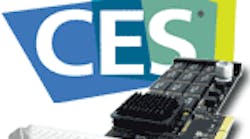PLX Technology NAS 7825
Fusion-io ioDrive
SanDisk iSSD
Toshiba SDHC
CES 2011 and Storage Visions shared the same venue, Las Vegas, again. Of course, Storage Visions was a bit smaller being held at the Riviera Hotel. We had a chance to attend both and grab a bunch of videos as well. Check out our CES videos and Storage Vision videos on Engineering TV trade shows section. Check out the other articles on our CES 2011 Trade Show page.
Non-volatile storage dominated both shows. Yes, hard drives are still everywhere and 6 Gbit/s SATA remains a hot item but enterprise and multimedia storage were the hot topics for hard drives. There is also more flash and hard drive mixing in addition to the hybrid drives like Seagate's Momentus XT (see Seagate Delivers 2nd Generation Hybrid Hard Drive).
Marvel latest dual channel SATA controller is an interesting example. It works as a conventional SATA controller with any operating system supporting any mix of SATA drives. It also implements a feature called HyperDou that currently works only with Microsoft Windows because a driver is required. HyperDou blends a flash drive with a hard drive providing a file-based caching system. This differs from the block level caching system that many other, higher end SATA/SAS controllers implement. The caching mechanism works automatically but Marvell also includes an application for power users to specify what files to store on the flash drive. Marvell implements two caching approaches. One stores "hot" files on the flash drive and the hard drive. This safe mode means the hard drive always contains a valid directory system. The other approach combines the flash and hard drives so a file will only be stored on one or the other. The downside is that both drives are needed for proper operation. Expect to see this controller on motherboards coming soon to your PC.
NAS (network attached storage) boxes were all over CES with a heavy skew towards multimedia storage. It remains to be seen whether this market can take off given the DRM (digital rights management) mess. Still, NAS is definitely a hot topic.
One of the NAS chips is from PLX Technology. PLX Technology's NAS 7825 (Fig. 1) is an SoC with a dual ARM11 processor. Twos seem to run in this design including two RGMII Ethernet ports, two SATA interfaces, two USB 2.0 ports, and two x1 PCI Express 1.0 ports. Ok, there is only one DDR2 memory controller but the Ethernet ports include a TCP/IP offload engine (TOE). The chip targets consumer NAS router/gateway applications. We had a look at their latest reference design.
Fusion-io was showing how to accelerate enterprise servers with the Fusion-io ioDrive (Fig. 2). A single x4 PCI Express provides access to as much as 320 Gbytes of SLC flash or 640 Gbytes of MLC flash. Fusion-io takes a different approach than simply providing a basic solid state drive (SSD) that would have SATA overhead. Instead it provides a managed block storage system. This allows the system to achieve a latency as low as 26µs. Mutiple boards can be combined providing a RAID configuration.
Embedded developers will likely forego the enterprise solution for a smaller flash alternative like this one from SanDisk. The SanDisk iSSD (Fig. 3) is a single chip flash drive with a SATA interface (see SATA Flash On A Chip) The surface mount chip is designed for applications that need rugged, embedded storage. It is available in sizes up to 64 Gbytes at this point.
Datalight was on handle to talk about their flash memory management and file management software. Embedded developers that want to deal directly with flash instead of using a more expensive chip like the SanDisk iSSD can take advantage of the stacks available from Datalight. Datalight provides more than simple access to flash. It also can provide wear leveling and file transaction support.
Flash has its challengers. MRAM is one of them and Everspin is the supplier. We had a chat about their latest SPI 4 Mbit serial memory chip, the MR25H40. It has a 20 year retention and is a pin-compatible replacement for flash chips. This chip is finding a home in a range of applications such as SAS controllers replacing battery backed RAM. MRAM performance matches RAM with the advantage of non-volatility. It is faster and more durable than flash and even FRAM, another non-volatile storage solution.
Viking Modular Solutions had a number of items on display. Two are of note for embedded develoeprs. The first is their SATA Cube3, an alternative to SanDisk's iSSD. The other is called SATADIMM. This is also a SATA device but one that plugs into a standard DDR3 socket. It draws power from the socket and has a SATA connector for accessing the memory. It is also possible to design a motherboard that accesses the SATA interface using unused DDR3 pins. It is an interesting approach.
Toshiba was showing off its SDHC memory cards (Fig. 4). They are designed for applications such as HD movie storage. They have a read speed of 95 Mbytes/s with write speeds up to 80 Mbytes/s. They are ideal for high resolution cameras and camcorders. Of course, they can handle other embedded applications as well. Versions are available up to 64 Gbytes.
On Engineering TV
Check out the lastest CES videos and Storage Vision videos on Engineering TV including these:

